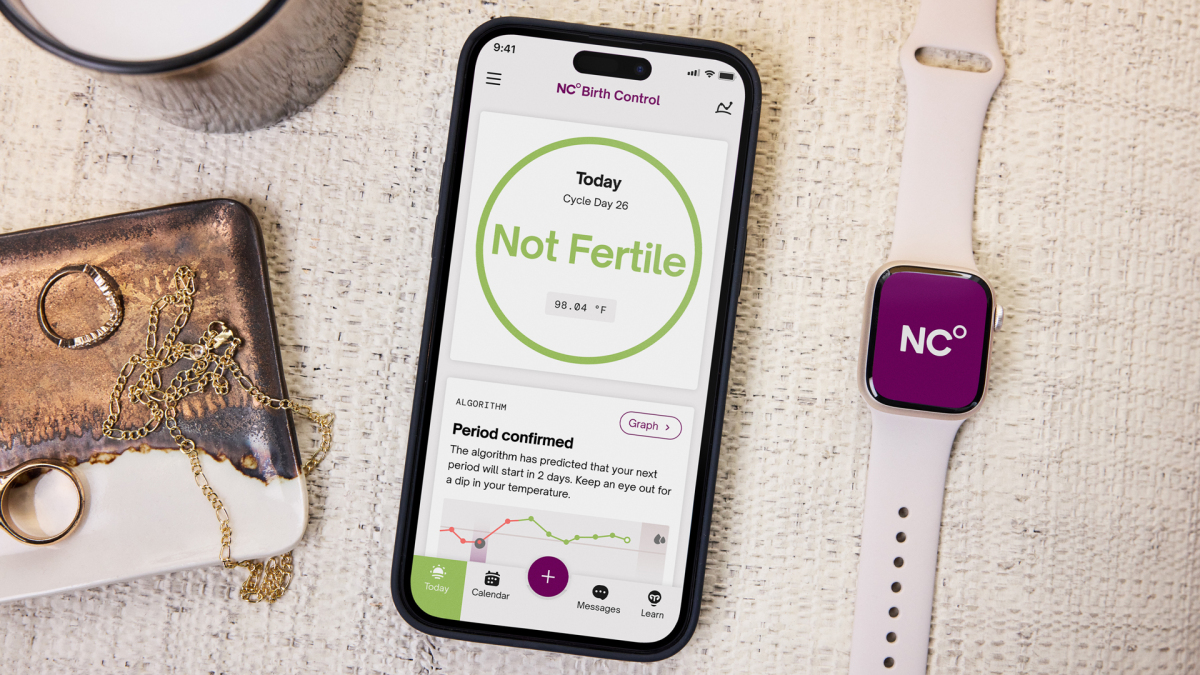Entertainment
Natural Cycles is coming to Apple Watch. So is it safe to use as a contraceptive?

The fertility tracking app Natural Cycles revealed today it has received clearance from the U.S. Food and Drug Administration (FDA) to be integrated into the Apple Watch — a device estimated to be on the wrists of over 100 million people worldwide.
Natural Cycles made history in 2018 when it became the first digital contraceptive method to be approved by the FDA, combining inputted temperature data from users with its algorithm to work out individuals’ fertile and non-fertile days during their menstrual cycle. It’s now about to be integrated into the most popular smartwatches on the planet.
The request for inclusion on the Apple Watch, which has offered body temperature-based ovulation tracking since its Series 8 version was released in 2022, has been the highest requested feature of Natural Cycles’ 3-million-strong user base according to the company. It has already been used for over a year on the Oura Ring, after winning FDA clearance for it in 2021.

Credit: Natural Cycles
But is the method that Natural Cycles supports, the fertility awareness method, safe for Apple Watch users to now consider as their contraceptive method?
How does Natural Cycles work?
Natural Cycles may have hailed a new generation of contraception, but it didn’t arrive without controversy. It helps users practice the fertility awareness method, a rebranding of natural family planning that involves heavily monitoring changes in your body to assess your fertile and non-fertile days every month; as a non-hormonal method, it has proven attractive to many who are concerned about hormonal methods’ safety and possible side effects.
The fertility awareness method works on the premise that there are just six days in a menstrual cycle that a woman can become pregnant – the day of ovulation, and the five days prior to it in which sperm may survive and fertilise the released egg cell.
Natural Cycles uses the temperature curve provided by data to calculate the day of ovulation and the days after it, helping it determine when you can have unprotected sex safely, and when you can’t. It’s then up to you to use a barrier method like a condom on the unprotected days, if you want to have sex. Up until this point, users have had to manually input this data every morning when they wake up, using a thermometer to measure their basal temperature.

Credit: Natural Cycles
Natural Cycles’ impressive 98 percent efficacy rate as a method only works – like many but not all contraceptive methods – if it is followed consistently and correctly; look at ‘typical use’ and that number quickly depletes to 93 percent. For comparison, the combined and progesterone contraceptive pills share a similar disparity between perfect and typical use, with their efficacy dropping if say a pill is missed.
Natural Cycles’ reliance on temperature data can also be heavily impacted by imperfect use down to scenarios that in many cases aren’t the user’s fault. Not only does it need to be measured at the same time each day – something that is presumably more of an issue with manual thermometer use than it is with wearable tech – but Dr. Shazia Malik, a consultant obstetrician and gynaecologist in the UK, is concerned that “wearing a watch isn’t somehow going to exclude the things that make temperature readings less accurate.”
Her list of possible scenarios was extensive: “Drinking alcohol the night before, battery lows overnight, moving, not getting enough sleep, if your temperature goes up because you’re unwell, if your cycles are irregular…”
Natural Cycles, the fertility awareness method, and the realities of typical use
As a result, Natural Cycles has had its wrist slapped in more than one market for not being more upfront about the realities of typical use. In 2018, a Swedish hospital reported that 37 of 668 women who had sought an abortion there in a three-month period had used Natural Cycles as their sole method of birth control. The Swedish Medical Products Agency investigated the cases and found that while the number of pregnancies was in line with Natural Cycles’ failure rate, the company was told to “clarify the risk of unhad wanted pregnancies” in its instructions, which it did.
During the same year, the UK’s Advertising Standards Agency found a Natural Cycles Facebook advert’s self-description of being a “highly accurate” method was misleading, and they were warned about exaggerating the efficacy of Natural Cycles’ method as a form of contraception.
Elina Berglund, CEO and co-founder of Natural Cycles, told Mashable that the likelihood of having an unintended pregnancy because of the algorithm was “really low”, and added that users in cohorts around 30 years of age can become riskier in their behaviours, presumably because they are more likely to be settled in their lives and less worried about getting pregnant. Malik echoed this, saying, “You should only use [fertility awareness methods] if getting pregnant isn’t going to be a disaster.”

Elina Berglund, CEO and co-founder of Natural Cycles.
Credit: Natural Cycles
But can the integration into wearable technology improve this ‘typical’ use? Berglund added that she was aware that the Apple Watch’s current period tracking data was already being used by watch owners under the radar as a fertility awareness method. “We are still the only app that is FDA approved and cleared for use as contraception. We’ve published more than four studies just on contraceptive effectiveness, and it’s not just effectiveness that’s important — it’s the ease of use and how it fits in with women’s lives.” With the Apple Watch integration, she said, “We believe the drop off rates will be lower.”
Protecting user data in a post-Roe world
In the post-Roe climate, intimate access to sensitive health information through fertility tracking apps has raised privacy concerns. Natural Cycles’ reassurance that the company protects users’ data lies in its subscription model; Berglund said, “We’re not incentivised to monetise people’s data and we never would. Natural Cycles would never sell a user’s data and as a medical device for contraception this is something we’ve been audited against.”
Jen Catilder, program director of *Privacy Not Included at the Mozilla Foundation, told Mashable, “Based on our research, Natural Cycles is one of the better reproductive health apps when it comes to privacy.”
“They don’t sell data. While they do share some data for targeted advertising, it is limited,” she said. “They limit how data can be shared with law enforcement in ways that look good to us. They have a decent track record at protecting their user’s personal information. This is all good.”
Catilder warned, however, that not all reproductive health apps were created equal, and that others on the market are “truly awful.”

It’s important to know where your data could be going.
Credit: Vicky Leta / Mashable
In the UK, which is Natural Cycles’ second-biggest market, demand in methods like Natural Cycles is growing according to Alice Pelton at The Lowdown, the world’s first contraceptive review platform. “Millions of women are desperate for better non-hormonal methods of contraception,” Pelton told Mashable. “Why? Because innovation and investment into new contraceptive methods has been hugely lacking for years.”
Pelton is conscious of the criticisms around digital contraceptives, but added that they “are definitely not right for everybody but work really well for some individuals. You need to be engaged, proactive and disciplined to use these apps.” Lowdown reviews, she adds, have suggested that many users have found the morning temperature checks for Natural Cycles “annoying to remember, and don’t like the beeping sound the thermometer makes when they use it. [The Apple Watch integration] is a great step forward, and means women with an Apple Watch don’t need to buy another device.”
“Millions of women are desperate for better non-hormonal methods of contraception. Why? Because innovation and investment into new contraceptive methods has been hugely lacking for years.”
MSI Reproductive Choices’ medical director Dr. Dhammika Perera told Mashable that he was overall very positive about wearable tech in health, and that a fertility tracking app “has definitely got value for some.” When it comes to unintended pregnancies, Perera was far more concerned about misinformation on social media than he was about apps promoting the fertility awareness method.
But Perera noted that the 3 million users already subscribed to Natural Cycles was not a large number of users in his view, and that he still wouldn’t recommend using a method like Natural Cycles to somebody close to him. “I would say to try something with a higher efficacy rate first — the most efficacious method, even for younger generations, are the long acting reversible contraceptives (LARCs).”
Topics
Health
Sex & Relationships
-

 Business7 days ago
Business7 days agoThis camera trades pictures for AI poetry
-

 Business6 days ago
Business6 days agoTikTok Shop expands its secondhand luxury fashion offering to the UK
-

 Business7 days ago
Business7 days agoBoston Dynamics unveils a new robot, controversy over MKBHD, and layoffs at Tesla
-

 Business5 days ago
Business5 days agoMood.camera is an iOS app that feels like using a retro analog camera
-

 Business5 days ago
Business5 days agoUnitedHealth says Change hackers stole health data on ‘substantial proportion of people in America’
-

 Business4 days ago
Business4 days agoTesla’s new growth plan is centered around mysterious cheaper models
-

 Business3 days ago
Business3 days agoXaira, an AI drug discovery startup, launches with a massive $1B, says it’s ‘ready’ to start developing drugs
-

 Entertainment5 days ago
Entertainment5 days agoFurious Watcher fans are blasting it as ‘greedy’ over paid subscription service




























